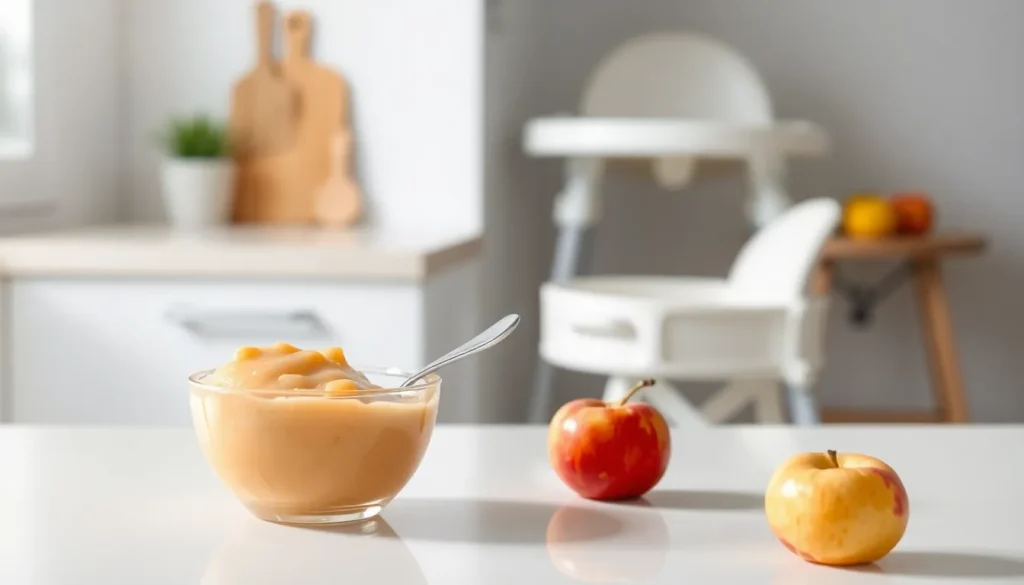When it comes to baby food, there’s often a struggle with which nutritious goodies make the cut. Parents scratch their heads over everything from mashed bananas to pureed carrots, but what about applesauce? Can babies have applesauce? Spoiler alert: yes, they can, and it can be quite the delightful addition to their budding diet. But before you take a bite out of that jar, there are some juicy details worth exploring. Let’s dig into the world of applesauce for your little one and find out why this sweet treat deserves a spot on their menu.
Table of Contents
ToggleNutritional Benefits of Applesauce for Babies

Applesauce brings a wealth of nutritional benefits that can be great for growing babies. First, let’s chat about fiber. This naturally sweet treat is packed with fiber, which helps keep tiny tummies happy and promotes a healthy digestive system. Then there’s vitamin C, which not only supports a baby’s immune system but also encourages healthy skin and tissue repair. You might also find antioxidants lurking within, working hard to ward off those pesky free radicals. These are definitely not a threat you want your baby dealing with too soon. Plus, applesauce is generally low in calories, making it a great option when paired with other foods. So, whether it’s mixed with oatmeal or served solo, applesauce can be a powerhouse in a baby’s diet.
When to Introduce Applesauce
Timing is everything when it comes to introducing new foods to your baby. So, when’s the right time for applesauce? Experts suggest starting solids around 6 months of age. That’s when most babies are ready to explore new tastes and textures. As they adapt to swallowing and digesting different foods, introducing applesauce can be a cinch. It’s smooth, simple, and well-tolerated. Just make sure to start with a small amount to see how your baby reacts. If all systems are go, there’s no stopping this sweet treat from becoming a favorite.
Preparing Applesauce for Babies
Making applesauce at home is a fantastic and easy way to ensure your baby gets the very best. Begin by selecting ripe, organic apples, less pesticide is always a plus when it comes to baby food. After peeling and coring, chop them into small pieces. Then, toss those apples into a pot with a dash of water, cover, and let them simmer over low heat until they soften, usually 15-20 minutes. Once cooked, simply blend them into a smooth consistency suitable for your little one. The best part? You can adjust the texture as your baby grows. For younger babies, a smoother sauce is ideal, while older babies may appreciate a bit of texture.
Possible Allergies and Considerations
While applesauce is generally a safe choice, parents should be aware of any individual allergies. Though rare, some babies might have sensitivity to apples. Introducing new foods one at a time is crucial as it helps identify any potential reactions. Observe for signs like rash, hives, or digestive issues after enjoying applesauce. If any of these appear, consult your pediatrician right away. Also, keep in mind that some store-bought applesauce varieties contain added sugars or preservatives. Always read labels to ensure your baby is only indulging in the good stuff.
Homemade vs. Store-Bought Applesauce
Deciding between homemade and store-bought applesauce can often feel like a daunting debate, but both options have their merits. Homemade applesauce is fresher, free from preservatives, and lets you control the ingredients fully. Plus, there’s something incredibly satisfying about creating your own baby food from scratch. On the flip side, store-bought applesauce can be a convenient option for busy parents. Just be sure to pick varieties that are organic and have simple ingredients, ideally, just apples and maybe a little cinnamon. For those days when time is of the essence, store-bought can save the day without compromising nutritional value.
Serving Suggestions for Babies
Now that you’ve got applesauce prepared, how can you serve it? Some parents blend it into cereals or mix it with yogurt for a nutritious twist. Others might pair it with sweet potatoes or even introduce it as a dip alongside soft fruit slices, though, of course, take care to cut those slices appropriately for little hands. Applesauce can also be frozen in ice cube trays for easy serving sizes, which makes it a breeze to thaw and serve at a moment’s notice. Adding a sprinkle of cinnamon can elevate the flavor, making your little one love it even more.








